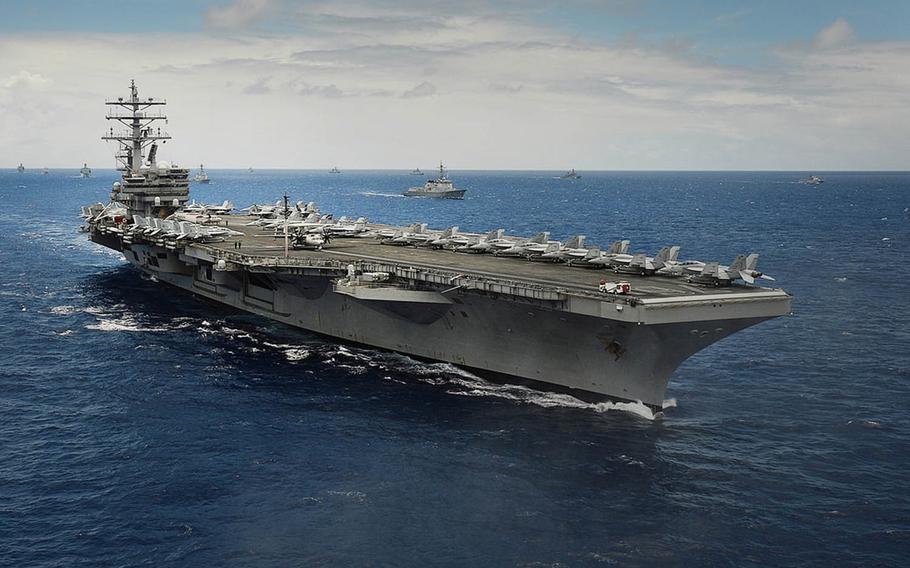
The USS Ronald Reagan departed San Diego Monday, Aug. 31, 2015, for Yokosuka Naval Base, Japan. UP to 20,000 people are expected to turn out Sunday, Sept. 13, 2015, in Yokosuka to protest the impending arrival of the Reagan and a set of security bills that would broaden Japan’s combat options. (Courtesy of the U.S. Navy)
YOKOSUKA NAVAL BASE, Japan — Organizers say they expect 10,000-20,000 people to turn out Sunday in Yokosuka to protest the impending arrival of aircraft carrier USS Ronald Reagan and a set of security bills that would broaden Japan’s combat options.
Committees organized by labor unions and the Japanese Communist Party are sponsoring the event, spokesman Hideo Higashimori said Friday.
The name of the demonstration, which will take place near the base, translates to “Rally for protesting against Yokosuka’s eternal homeport for a nuclear-powered aircraft carrier.”
The demonstration will begin with a “pre-event” at Verny Park, which overlooks the U.S. Navy’s harbor, between noon and 1 p.m., Higashimori said.
Demonstrators will continue to gather at the park until 2 p.m., when they will march down Route 16 from Yokosuka Art Theater to NTT Yokosuka, across the road from the base’s gates. The demonstration is scheduled to conclude at 2:30 p.m., Higashimori said.
Base officials sent out an email alert Friday advising personnel to avoid the protest.
“These activities in Japan are always intended to be peaceful, but it is prudent to avoid contact and leave the vicinity of protests and demonstrations to ensure they remain nonconfrontational,” said the alert, which warned of possible traffic congestion near the main gate from 1-4:30 p.m.
In 2008, thousands protested the arrival of the USS George Washington, the first nuclear-powered carrier to be based in Japan. George Washington replaced the USS Kitty Hawk.
The Reagan is expected to arrive next month. Most of its sailors swapped places with the George Washington crew last month.
The George Washington will eventually head for Virginia, where it will undergo a midlife overhaul and refueling expected to take three to four years.
Nuclear power has long faced opposition in Japan, where more than 50 reactors operated prior to the 2011 earthquake and tsunami that led to meltdowns at the Fukushima Dai-ichi nuclear power plant. The George Washington, which was undergoing pier-side maintenance at the time, hurried out to sea to avoid contamination.
Opposition to nuclear power has remained high in polls ever since the disaster; however, Prime Minister Shinzo Abe’s administration supports restarting several of Japan’s reactors, all of which suspended operation after the Fukushima meltdown.
In August, Kyushu Electric Power restarted a reactor in southern Japan, making it the first to resume operations since 2011.
Protesters will also demonstrate against security legislation being debated in the national Diet’s upper house that would allow Japan to defend its allies in combat, even if its people are not directly under attack.
Polls indicate majority opposition to the security bills. Japan is constitutionally barred from waging war to settle international disputes, but Abe insists the legislation is constitutional.
Twitter: @eslavin_stripes